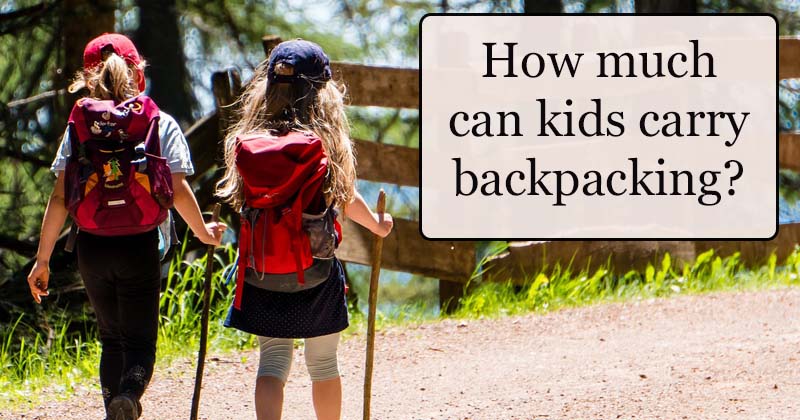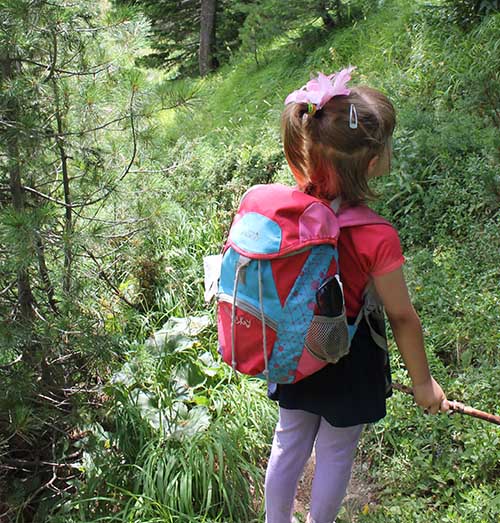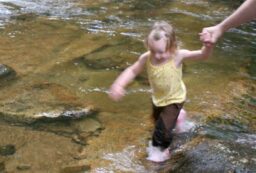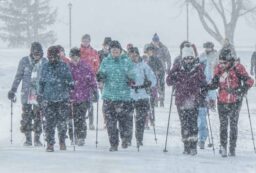One of the challenges of hiking or backpacking with children is that you end up carrying most (if not all) of their gear. As soon as your kids get old enough, you might be eager to let them carry some of the weight. But how much weight can kids carry? And how much should they carry?
Quick Answer:
Preschool aged kids should only carry approximately 5% of their bodyweight while hiking. As kids get older and in better condition, they can carry 10% to 15% of their bodyweight. However, it’s better to keep the pack even lighter so your kids don’t end up hating hiking.
The % of Bodyweight Rule
Most studies and experts on the topic find that kids should carry no more than 10-20% of their bodyweight in their packs. But this advice is usually meant for school backpacks and not hiking backpacks.
Hiking requires carrying a backpack for hours at a time over uneven terrain. A heavy hiking backpack will tire kids out quickly. It could even compress their spine and lead to injury. And, as one backpacking parent said at Reddit,
At a young, impressionable age, we want to be sure we don’t create opportunities for her to correlate backpacking with discomfort.
Pack Weight Guidelines By Age
Ages 2 to 4: Less than 5% of Bodyweight
When kids are this eager, they love to have their own backpack. It makes them feel special and grown up. But the novelty of carrying their own gear wears off quickly. Don’t be surprised if after just 100 yards of walking, your kids are already begging you to carry their pack for them.
It’s important to keep the backpack incredibly light (probably not more than a pound!): the heavier the pack is, the sooner they will get tired of it.
On short hikes, I’ll only put fun items in my two-year old’s pack, such as a few snacks, binoculars and whatever toy she wanted to bring. On longer backpacking trips, my three-year-old got a few light items like toilet paper or her fleece hoodie.
Tip: Bring carabiners or ties so you can strap your kid’s pack to your backpack. This is a lot easier than carrying the pack in your hands.
Ages 4-7: 5% of Bodyweight
If you are lucky, your 4-year old might carry their own pack for an entire hike. But most kids still can’t handle a pack for long at this age. My older daughter had me carrying her pack on backpacking trips (at least for part of the trek) until she was 6. She admittedly is a bit lazy though. 🙂
If you keep the weight at 5% of their bodyweight (which is around 1.7-2.5lbs pack weight for most kids) they are less likely to complain. And, if they do beg you to carry the pack for them, it won’t be too bulky to attach to your pack.
Ages 7-10: 5-10% of Bodyweight
By this age, some children are already very good hikers. They might be able to carry 10% of their bodyweight on a long hike. However, still pay attention to their posture as they hike. If your kids are leaning forward due to the strain of the weight, the pack is probably too heavy.
Ages 10-17: 10%-15% of Bodyweight
Children’s spines grow drastically during this phase of their life. For most girls, the growth spurt occurs between ages 10 and 12. With boys, it’s 13 to 15 years old. It’s important that they don’t strain their backs during these growth spurts. Otherwise they could end up with spinal issues like scoliosis.
So, even though your kids probably seem like they can “handle it” at this age, it’s still not smart to give them more than max 15% of their bodyweight to carry while hiking.
What Size Hiking Pack Should Kids Use?
How big of a hiking pack you can get for your kids will mostly depend on their torso length. A 30L pack simply isn’t going to fit on a kid with a 11 inch torso. Also pay attention to the shoulder strap width. I’ve had packs which rubbed against my daughter’s neck because the straps were set too narrow.
Below are general guidelines on what size (in liters) a kid’s hiking pack should be.
- 2-4 years old: Under 10L
- 4-7 years old: 10-20L
- 7-10 years old: 18-30L
- 10-17 years old: 30+L
For really little kids, I like the Deuter Kikki (8L) pack, which is affordable, super cute and can be used as a school bag too.
For elementary school aged kids, I like the REI Tarn 18L kids pack, though my daughter would prefer a cuter pack.
Once your kids get bigger, then invest in a good pack with an adjustable torso length so they can still use it as they grow. I like REI’s Tarn 40L kids pack and the Gregory Icarus Youth 40L pack.
![]()
Tip:
Pick a backpack for your kid that also fits you. After setting up camp on backpacking trips, I’ll use my daughter’s pack as our day pack. It’s not the best fit but works well enough for a day pack.
What Gear to Put in a Child’s Backpack
Having your kids carry their own pack (even if you eventually end up carrying it) is good training for them. I’ve also found that kids are more likely to use items – like remembering to drink water or put on an extra clothing layer when cold – when those items are in their own pack.
Little Kids
On day hikes, I only put “fun” items in my little kid’s pack. These include snacks, binoculars, specimen collection cups, and whatever stuffed animal she insisted on bringing.
On backpacking trips when my daughter was very little, I would have her carry the lightweight but bulky items. This created more space in my pack (which was desperately needed since I was carrying all the food, tent, etc.!). By 4 years old, my daughter usually carried her sleeping bag, the toilet paper, and her stuffed animal.
Older Kids
As your kids get older, you can give them more to carry and lighten your load. At 9, my daughter would carry her own sleeping bag, some clothes, snacks, and water plus some lightweight bulky items like toilet paper.
You might want to add some survival items to your kid’s pack too, just in case you get separated. For example, it’s smart for kids to always have a rain jacket, fire-starting kit, whistle, headlamp, snacks and water filter with them.
Weigh the Pack!
It’s very easy to overfill a child’s backpack with too much weight. Ideally, you should weigh your kid’s pack so you know exactly how heavy it is. Don’t guesstimate! You want your kids to have a good time hiking and backpacking so they will want to do more of it.
How much weight do your kids carry backpacking? Let us know in the comments.
Sources:
https://www.reddit.com/r/CampingGear/comments/agbpdw/youth_hiking_backpacks/
https://www.reddit.com/r/Ultralight/comments/6g6k0s/backpacking_with_my_4yr_old/
https://www.sharecare.com/health/kids-teens-health/how-weight-student-carry-backpack
https://www.outdoors.org/articles/amc-outdoors/how-heavy-should-my-childs-backpack-be
https://apnews.com/article/3e6ea8be177d4d169cfe347a83550df9
https://www.backpacker.com/skills/how-far-can-kids-hike-how-much-can-they-carry/
https://www.abc.net.au/news/2020-03-15/child-school-bag-should-weigh-10-per-cent-of-body-weight/12032558
https://www.theweek.in/news/sci-tech/2019/07/04/New-study-reveals-how-much-weight-children-should-carry-in-school-bags.html
static/file/Backpacks.pdf
https://atm.amegroups.com/article/view/34315/html














1 Comment
Amy Harman
July 16, 2021 at 6:08 amMy 8 year old 60ish pound son and 11 year old 130ish pound daughter both carry around 15 pounds. They carry sleeping bag, blowup mat, lightweight pillow, clothing, jackets, snacks, and 1-2 liters of water. If the trail has some steep spots, we will often rearrange my son’s gear to get him down to 10 pounds and take that weight on ourselves.